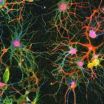The enigma of the missing stars in space may be solved
Researchers from Bonn and St. Andrews provide an explanation for the discrepancy
2010-11-19
(Press-News.org) New stars are born in the Universe around the clock – on the Milky Way, currently about ten per year. From the birth rate in the past, we can generally calculate how populated space should actually be. But the problem is that the results of such calculations do not match our actual observations. "There should actually be a lot more stars that we can see," says Dr. Jan Pflamm-Altenburg, astrophysicist at the Argelander-Institut für Astronomie of the University of Bonn.
So, where are those stars?
For years, astronomers worldwide have been looking for a plausible explanation for this discrepancy. In cooperation with Dr. Carsten Weidner from St. Andrews University, Dr. Pflamm-Altenburg and Professor Dr. Pavel Kroupa, Professor of Astrophysics at the University of Bonn, may now have found the solution. It seems that so far, the birth rate has simply been overestimated. But this answer is not quite as simple as it sounds. Apparently, the error of estimation only occurs during periods of particularly high star production.
The reason for this lies in the manner in which astronomers calculate the birth rate. "For the local Universe – i.e., the Milky Way as our home and the adjacent galaxies – it is relatively simple," explains Professor Kroupa. "Here we are able to count the young stars one by one, using huge telescopes."
The problem with this method is that it only works for our immediate vicinity. But many galaxies are so distant that even the best telescope simply overlooks their small stars. As luck would have it, however, occasionally there is an especially large whopper among the newbie's in the sky. Such a star will, even if it cannot be directly discovered as an individual star, leave its traces in the light of even the farthest galaxies. The number of large whoppers then determines the strength of this trace.
In our immediate vicinity, these large whoppers occur with a fixed probability. There are always about 300 lightweights to one "big star baby." This numerical ratio seemed to be universal. So it was sufficient for astronomers to know the number of the large whoppers, for this allowed them to determine the number of new-born stars by simply multiplying the former number by a factor of 300.
Population explosion in space
Recently, however, some Bonn astronomers around Professor Kroupa began doubting the fixed ratio. Their hypothesis is that at times when the galactic nurseries are booming, they generate a considerably higher number of stellar heavies than normal. The reason for this, according to this theory, is so-called stellar crowding. For stars are not single children; they are born in groups, as so-called star clusters. At birth, these clusters are always of a similar size – no matter whether they contain 100 star embryos - or 100,000.
Consequently, at times of a high birth rate, space can be at a premium in star clusters. Astronomers call such galaxies that are particularly rich in mass "ultra-compact dwarf galaxies," or UCD's for short. In these, things are so tight that some of the young stars fuse during formation. Thus, more stars rich in mass than normal emerge. The "small to large" ratio is then only about 50 to 1. "In other words, we used to estimate the number of newly formed small stars by far too high," explains Dr. Carsten Weidner.
The researchers from Bonn and St. Andrews have now corrected the birth rates according to the projections of the stellar crowding theory. With an encouraging result – they actually arrived at the number of stars that can be seen today.
INFORMATION:
Contact:
Dr. Carsten Weidner
School of Physics and Astronomy, University of St. Andrews
Ph: 0044-1334/461673; Email: Carsten.Weidner@st-andrews.ac.uk
Dr. Jan Pflamm-Altenburg
Argelander-Institut für Astronomie der Uni Bonn
Ph: 0049 228 73-5656; Email: jpflamm@astro.uni-bonn.de
Prof. Dr. Pavel Kroupa
Ph: 0049 0177 956 6127; Email: pavel@astro.uni-bonn.de
END
ELSE PRESS RELEASES FROM THIS DATE:
2010-11-19
The casting sessions aren't just for movie stars, but what is involved in casting decisions that can launch fashion models to fame – or at the very least – to land a job? Stephanie Sadre-Orafai, a University of Cincinnati assistant professor and socio-cultural anthropologist, spent 11 months of fieldwork at a premiere casting agency in New York to uncover the decisions that happen behind the scenes of the glossy photos and slick commercials. Her research, "Polaroids and Go-Sees: Casting Encounters, Casting Epistemologies," was presented Nov. 17 at the 109th annual meeting ...
2010-11-19
HOUSTON – (Nov. 18, 2010) – Discovery of a fifth gene defect and the identification of 47 DNA regions linked to thoracic aortic disease are the subject of studies released this month involving researchers at The University of Texas Health Science Center at Houston (UTHealth).
In both studies, the investigators have identified alterations in the genetic material or DNA that affect the ability of smooth muscle cells, which line the aorta and other blood vessels, to contract. This can lead to a weakening of the wall of the aorta, the main blood vessel leading out of the ...
2010-11-19
Technical progress in the automobile industry is unbroken. But, the sector has still some hard nuts to crack: "Lead-free materials" is one of the challenges – hidden behind this challenge is a EU environmental directive which, based on a step-by-step plan, gradually bans all lead-containing materials and components from automotive vehicles – such as piezoelectric components. These elements are important for diesel engine injectors, for example, which control the supply of fuel to the combustion chamber.
The problem: Up to now lead-zirconate-titanate (PZT) is the material ...
2010-11-19
A short push on the light switch – and the whole ceiling lights up in a uniform and pleasant color. This "illuminated sky" is not available as yet, but researchers from all over the world are working on it flat out. The technology behind this marvel is based on organic light-emitting diodes, or OLEDs for short. These diodes use special molecules to emit light as soon as current passes through them. Although the first OLEDs have only recently become available, they are small and expensive. A flat disk with a diameter of eight centimeters costs around Euro 250. Experts of ...
2010-11-19
Scientists at Johns Hopkins have identified a compound that could be used to starve cancers of their sugar-based building blocks. The compound, called a glutaminase inhibitor, has been tested on laboratory-cultured, sugar-hungry brain cancer cells and, the scientists say, may have the potential to be used for many types of primary brain tumors.
The Johns Hopkins scientists, are inventors on patent applications related to the discovery, caution that glutaminase inhibitors have not been tested in animals or humans, but their findings may spark new interest in the glutaminase ...
2010-11-19
PHILADELPHIA – Cells have their own version of the cut-and-paste editing function called splicing. Researchers at the University of Pennsylvania School of Medicine have documented a novel form of splicing in the cytoplasm of a nerve cell, which dictates a special form of a potassium channel protein in the outer membrane. The channel protein is found in the dendrites of hippocampus cells -- the seat of memory, learning, and spatial navigation -- and is involved in coordinating the electrical firing of nerve cells. Dendrites, which branch from the cell body of the neuron, ...
2010-11-19
Montreal, November 18, 2010 – Schizophrenia is a mental disorder that differs between the sexes in terms of age at onset, symptomatology, response to medication, and structural brain abnormalities. Now, a new study from the Université de Montréal shows that there is gender difference between men and women's mental ability – with women performing better than men. These findings, published recently in, Schizophrenia Research, have implications for the more than 300 000 affected Canadians.
"We are the first to report sex differences in brain function of schizophrenics," ...
2010-11-19
The Soufriere Hills Volcano on Montserrat erupted in 1995, and an international team of researchers has studied this volcano from land and sea since then to understand the workings of andesite volcanos more completely.
"To the extent that the Soufriere Hills Volcano is typical of andesitic dome building volcanoes, results from this research can be expected to apply more generally," said Barry Voight, professor emeritus of geosciences, Penn State.
Voight and R. S. J. Sparks, the Channing Wills professor of geology, Bristol University, guest edited and introduced a special ...
2010-11-19
People who contract gastroenteritis from drinking water contaminated with E. coli are at an increased risk of developing high blood pressure, kidney problems and heart disease in later life, finds a study published on bmj.com today.
The findings underline the importance of ensuring a safe food and water supply and the need for regular monitoring for those affected.
It is estimated that E. coli O157:H7 infections cause up to 120,000 gastro-enteric illnesses annually in the US alone, resulting in over 2,000 hospitalisations and 60 deaths. However, the long term health ...
2010-11-19
Vitamin D is somewhat of an unusual "vitamin," because it can be made in the body from sunlight and most foods do not contain vitamin D unless added by fortification. Synthesis of vitamin D in the body requires exposure to ultraviolet light and can be influenced by genetics, skin color, and sun exposure. Reports of greater than expected vitamin D insufficiency coupled with emerging evidence that higher circulating concentrations of this nutrient may protect against cardiovascular disease have prompted a renewed interest in teasing out how environment, genetics, and behavior ...
LAST 30 PRESS RELEASES:
[Press-News.org] The enigma of the missing stars in space may be solved
Researchers from Bonn and St. Andrews provide an explanation for the discrepancy



